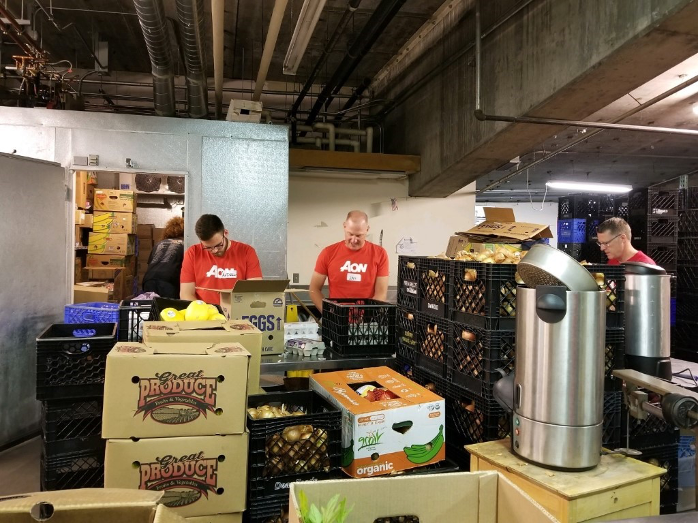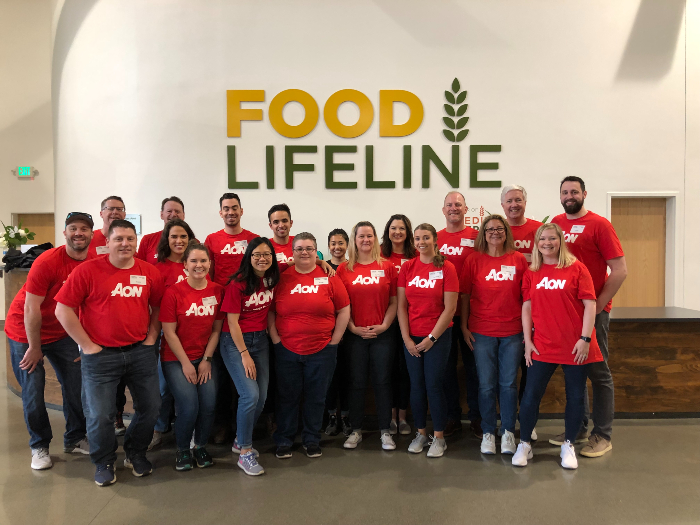As a University of Washington student selecting a major in 1986, Jay Krueger discovered chemical engineering grads earned the highest salaries for several years running. That made the decision easy.
“I knew it would lead to a profitable career, but otherwise, I had no idea!” said Krueger. “I knew I wanted to run a company someday.”

Since earning his chemE B.S., and later an MBA from Purdue University, Krueger has worked in the energy sector, finance and high tech. Now, he’s leading Aon’s Seattle market. Krueger’s career reflects his belief that, “Engineering is a foundation for so many different things.”

Jay Krueger and members of the Aon Seattle team prioritize community engagement.
Q: How did you go about your cultivating technical, business and leadership skills?
A: When I graduated, I felt the need to solidify my technical skills so I went to work for Shell Oil. Shell sent me back to school for postgraduate training as a control systems engineer, a role I remained in for four years. That checked my technical skill box.
Then I knew I needed to be able to sell, so I left Shell and went to Nalco Water and sold into major chemical companies in the Northeast. With my sights set on business next, I went to Purdue University Krannert School of Management and earned a Master’s of Science in Business Administration. This program bundled engineering and business and gave me experience in Purdue’s Technical Assistant program which granted startups with 40 hours of free consulting by grad students. It was terrific experience, hopping in a prop plane and flying around Indiana, writing business plans and finding funding for startups.
It was in that chapter where I met folks at Ernst & Young and they approached me to do business consulting for them. One of the two clients I picked up was Microsoft. They were growing globally and acquiring companies around the world and needed our help with global taxes and employee mobility. Next, I landed at Microsoft running Global Resources in the HR space, operating the Swiss entity I helped them implement while at Ernst & Young. That’s how I got involved with risk management, global benefits and healthcare which eventually led to the job I have today at Aon.
Q: What about your engineering background sets you up for success in a business role?
A: Aon hires more engineers than one would think because it’s all about risk management. As a trained engineer, I like to say I’ve been working in risk management since day one. When I worked for Shell, we would do tabletop exercises where we’d talk about dire scenarios and then how we would prevent that from happening. If you think about the risk management you learn in engineering, how you apply that to business development and design is so important. Being grounded in data is a game changer. So, I always encourage young people going to college to start out with a technical degree because of the foundational knowledge you can use and take anywhere.

Aon, a global professional services firm, provides risk, retirement and health solutions. Under the leadership of EVP and Resident Managing Director Jay Krueger, Aon’s Northwest market has achieved consistent double-digit year-over-year growth.
Q: How do engineers fit into the insurance business?
A: As an insurance company providing risk, retirement and health solutions, we hire engineers who do risk analysis and loss control. For example, we have business interruption insurance. If a business goes down, an insurance company pays out a certain amount to help sustain the business over the operational disruption. If a company wants to get a better insurance rate on business interruption insurance, they need to convince the underwriters that they will limit the risk if their business actually goes down. How do you do that? You analyze busines processes and analyze where there is risk.
We hire a lot of civil, mechanical and chemical engineers and even electrical engineers, because we have a whole division who does cybersecurity and forensics. In the Seattle office alone, we have 6-7 engineers who work in various capacities. This industry is a super cool way for engineers to get a close look at a lot of different businesses.
Q: With your proximity to HR departments and corporate approaches to recruiting and hiring, what can employers do to attract and retain engineering talent into non-traditional or unexpected roles?
A: There is a talent shortage across most industries. The challenge companies have is to attract and retain employees that are self-starters, adaptable, grounded in data and analytics and have a focus on outcomes. Companies need to have an Employee Value Proposition (EVP) and culture that resonates with Talent. Regardless of what business you’re in, Amazon, Microsoft, Costco, Starbucks, and Boeing are your competitors for talent. Having an EVP and culture that competes with those companies’ EVP and culture is key.
Q: What are some digital transformation practices you’re seeing that will have the most impact on the way organizations think about risk and protecting their assets? What role will engineers have in innovating and advancing those?
A: Intellectual Property (IP) risk is one of the merging risks that holds strategic importance for companies and engineers. In 1975, the five most valuable companies were IBM, Exxon Mobile, P&G, GE, and 3M. In 2018, the five most valuable companies were Apple, Alphabet, Microsoft, Amazon, and Facebook. This shows the shift from companies needing to protect property, plants and equipment to companies needing to protect IP.
As engineers, you are often responsible for developing and deploying IP for your employers. Thinking through how you manage the risk of IP infringement and theft as you often work with complex supply chains has never been more important.
Aon is now working with companies and insurance organization to quantify, protect and de-risk IP.
– Tia Over, The Engineering 100
